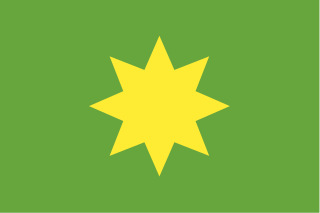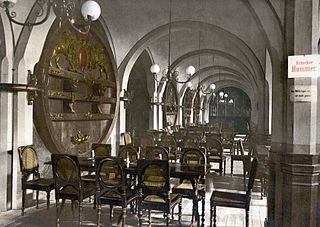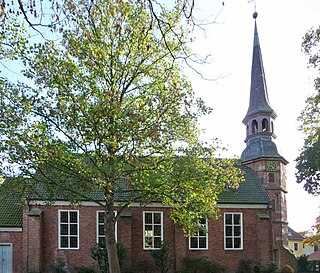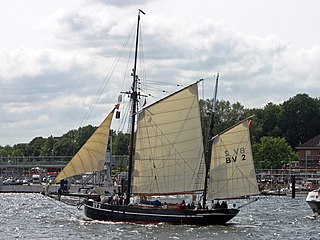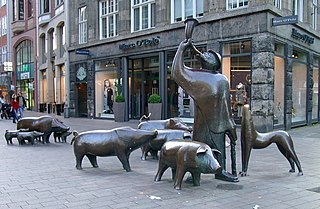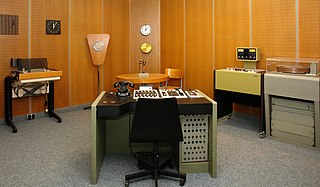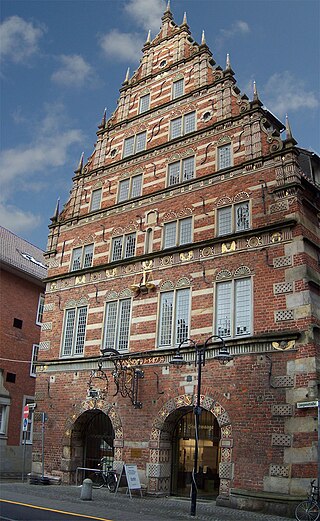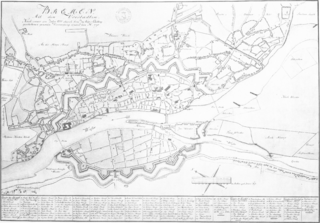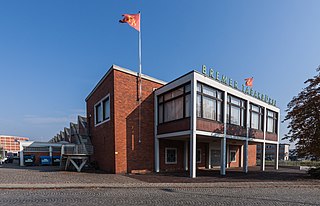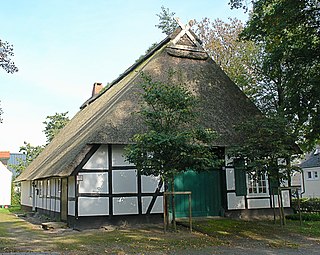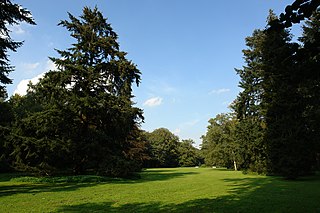49 Sights in Stadtgebiet Bremen, Germany (with Map and Images)
Legend
Premium Sights
Book tickets, guided tours and activities in Stadtgebiet Bremen.
Guided Free Walking Tours
Book free guided walking tours in Stadtgebiet Bremen.
Welcome to your journey through the most beautiful sights in Stadtgebiet Bremen, Germany! Whether you want to discover the city's historical treasures or experience its modern highlights, you'll find everything your heart desires here. Be inspired by our selection and plan your unforgettable adventure in Stadtgebiet Bremen. Dive into the diversity of this fascinating city and discover everything it has to offer.
Sightseeing Tours in Stadtgebiet Bremen1. Fangturm
In the 10th century, only the cathedral district was walled as a cathedral castle. From 1229 onwards, a ring wall was built around the entire old town, semicircular on the land side. In the 13th century, Bremen expanded westwards. From 1307 onwards, the new Stephanivorstadt was given a wall on the land side only. In the 15th century, the first brick phase of Bremen's architectural history, the city wall on the Weser side in the port areas of Schlachte and Tiefer was successively replaced by the gable sides of brick warehouses, so that only the battle gates remained of the original wall at Schlachte. The Stephaniviertel, on the other hand, did not receive a wall on the Weser side until the middle of the 16th century. After that, in 1551, the wall between the old districts and the Stephaniviertel was able to fall.
2. Antikolonialdenkmal
The Anti-Colonial Monument is a memorial in Bremen in the shape of a brick elephant. It is located in Nelson-Mandela-Park in the district of Schwachhausen, district of Bürgerweide-Barkhof opposite the Hermann-Böse-Gymnasium and near the main train station. It was originally erected as a Reich Colonial Monument in 1931, inaugurated in July 1932 and from then on was considered the central German colonial monument by the colonial movement. In 1989 it was rededicated as an anti-colonial monument.
3. St.-Stephani-Kirche
The Church of St. Stephani is a parish church located at the western end of Bremen's old town, which has been a listed building since 1973. It forms the urban centre of the old town Stephaniviertel, which was rebuilt in a modern way after being completely destroyed in the Second World War, with the exception of the church.
4. Seenotrettungskreuzer Bremen
The Bremen (III) was a former twin-screw motor lifeboat (MRB) of the German Maritime Search and Rescue Service (DGzRS), which had been converted into the first sea rescue cruiser in the early 1950s. This experimental cruiser was intended to prove that the developed concept of a daughter boat (TB) has proven itself in sea rescue operations.
5. Postamt 5
The Bremen 5 post office, also known as the main post office 5, was the central building of the Hanover Postal Directorate near the main railway station in Bremen and for many years one of the largest buildings in the Hanseatic city. From 1996 onwards, large parts of the house stood empty for a long time and were only partially used.
6. Bräutigam
Since the late Middle Ages, the Bremen Powder Towers have been the name given to three large round towers in Bremen, in which the powder supplies, weapons and ammunition needed in the event of war were stored. In addition, prisoners were also held on the ground floors of the powder towers.
7. Marmorsaal
The Marble Hall is an interior in the former coffee factory of the Kaffee HAG company. It is located in the former Kaffee-HAG-Werk I, which is located in the Überseestadt district of Bremen's Walle district, which was created in 2009. The company founder and then plant director Ludwig Roselius had the room equipped with marble wall coverings in 1914. The Marble Hall was the representative centre of the coffee factory and has been a Bremen monument since 1994.
8. Metalhenge
Metalhenge is the name of an astronomical vantage point and an art installation in Bremen, which are located at a height of about 40 meters on the eastern, disused part of the Blockland landfill in the Walle district.
9. Argo-Haus
The Argo Reederei was an important German shipping company based in Bremen. The focus of the activities was the scheduled service within Europe, in particular the trip to Finland, Great Britain and the Levant.
10. Unser Lieben Frauen
The Church of Our Lady is an Evangelical Protestant church situated northwest of the Market Square in Bremen, Germany. Like Bremen Cathedral, today's building dates from the 13th century. The brightly coloured stained-glass windows are the work of the French artist Alfred Manessier. In 1973, the church was listed under the monument protection act.
11. Ratskeller
The Bremen Ratskeller is the council wine cellar of the Townhall of Bremen. Since it was erected in the year 1405, German wines were stored and sold there. With its history over 600 years the Ratskeller of Bremen is one of the oldest wine cellars of Germany, furthermore the oldest wine barrel of Germany, a wine from Rüdesheim which is dated 1653, is stored here.
12. Überseemuseum
The Overseas Museum in Bremen is a Natural History and ethnographic museum in northern Germany. In an integrated exhibition of Nature, Culture and Trading, the museum presents aspects of overseas regions with permanent exhibitions relating to Asia, South Pacific/Oceania, Americas and Africa. The building is protected by the monument protection act.
13. Sankt Magni
The Evangelical Lutheran Church of St. Magni of the parish of St. Magni in Bremen is located in the district of Burglesum, district of St. Magnus, Unter den Linden 24. It is one of Bremen's most important buildings and is a listed building.
14. Waller Kirche
The Waller Kirche is a Protestant parish church in Bremen in the district of Walle, Lange Reihe 77. The church building consists of a nave from the 1950s and a Renaissance tower, both made of brick. Since 1973 it has been under Bremen monument protection (see List of cultural monuments in Walle#0837).
15. St. Michaelskirche
The church of St. Michael in Bremen-Vegesack, district Grohn, Friedrich-Humbert-Straße 133 and Grohner Bergstraße 1, was built in the years 1906-1908. It belongs to the Evangelical Lutheran parish of St. Michael of the Bremen Evangelical Church.
16. BV 2 Vegesack
The Vegesack is an iron sailing logger that was launched in 1895 at the Bremer Vulkan shipyard as a herring logger and has the fishing number BV 2. Since 2018, the ship has been listed as a movable monument.
17. Suding und Soeken
The Suding & Soeken building is a gabled house at No. 28 Langenstraße in Bremen, Germany. Referred to as a Kaufmannshaus or Kontorhaus, it is one of the city's few historic merchant houses to survive the war undamaged. It is noted for its projecting Renaissance bay window and its two-tiered Baroque stairway ascending from the hallway.
18. Warehouse XI
Speicher XI is a historic warehouse building in Überseestadt in Bremen, Germany, which is home to the Bremen Harbour Museum, the Bremen Centre for Building Culture and the Bremen University of the Arts, among others.
19. Schweinehirt und seine Herde
The Swineherd and His Herd is a bronze group of figures in Bremen-Mitte at the end of Sögestraße near the streets Am Wall and Herdentorsteinweg. It was erected in 1974 and is listed in the list of monuments and statues of the city of Bremen.
20. Overbeck-Museum
The Overbeck Museum is located in the listed "Old Packhouse" or "Kito House" in the Alte Hafenstraße in Bremen-Vegesack. It is the only museum in the Bremen city area dedicated to one of the founding fathers of the Worpswede artists' colony, the painter Fritz Overbeck (1869–1909), and his wife, the painter Hermine Overbeck-Rohte (1869–1937).
21. Bremer Rundfunkmuseum
The Bremen Radio Museum was founded in 1978 by radio enthusiasts and exhibits about 700 exhibits on 400 m² of exhibition space in the Bremen district of Findorff. The collection includes equipment from 80 years of radio, phonographic and television history as well as marine radio. Exhibits from all areas can be put into operation and demonstrated during guided tours.
22. Weserburg Museum für moderne Kunst
The Weserburg is a modern art museum in Bremen, Germany. Opened in 1991, it is located on the Teerhof peninsula next to the River Weser in an old factory building which was almost completely destroyed in the Second World War. Originally known as "New Museum Weserburg Bremen", it was Europe's first "collectors' museum", in that it conserves no permanent collection but mounts changing exhibition of private collections. It is one of the largest modern art museum spaces in Germany.
23. Villa Schröder
The Villa Schröder is an upper-middle-class residential building in Bremen, Vegesack district, Vegesack district, Weserstraße 78A/79, on the high banks of the Weser. The villa was built in 1887 according to plans by Ludwig Klingenberg and Hugo Weber and has been a listed building since 1996.
24. Kaiser-Friedrich-Denkmal
The Kaiser Friedrich Monument, a bronze equestrian monument created by Louis Tuaillon on Hermann-Böse-Straße in Bremen, was dedicated in 1905 to the memory of the German Emperor Frederick III, who reigned for only 99 days in 1888. It has been a listed building since 1973.
25. Rekumer Mühle
The Rekumer Mühle is a windmill in Rekum in the Blumenthal district of Bremen, Germany. Unlike four other well-preserved windmills in the city of Bremen, the mill is not a station on the Lower Saxony Mill Road.
26. Villa Waldwiese
The Villa Waldwiese in Bremen-Burglesum, district of St. Magnus, Am Lindenberg 18A + 18B, dates from 1893 and is a well-preserved example of the Schweizerhaus style in the region. Between 1910 and 1993, the longest-serving resident of the house was Dorothea Klosterkemper, née von Gröning, the widow of retired Major General Bernhard Klosterkemper. After her death, the garden was built on, so that the villa lost its free location in the countryside.
27. Stadtwaage
The Stadtwaage at No. 13 Langenstraße in Bremen (Germany) is the building in which the municipal weighing scales used to be housed. The facility was created in order to levy taxes and excise duties while protecting merchants and customers against fraud and dishonesty.
28. Friedehorstpark
The Friedehorst Park, also called the Lehnhof Park, is a green space in the Bremen borough of Burglesum on the border of states of Bremen and Lower Saxony. It is about 9 ha in area. It is home to the highest natural point in the state of Bremen reaching a height of 32.5 m above sea level (NHN). The park, which is open to the public, belongs to the Evangelical Church of Bremen.
29. Wal
The whale in Vegesack is a monument in Bremen-Vegesack. It was erected in 1978 in the pedestrian zone of Gerhard-Rohlfs-Straße and is listed in the list of monuments and statues of the city of Bremen.
30. Ölmühle
The oil mill of Franz Köcheln was a windmill located at the Stephanitor bulwark west of Bremen's old town. Its foundation remains made of large-format bricks were discovered in 2012 during an emergency excavation. The mill, which belonged to Franz Daniel Köcheln, stood in the area of the Weser railway station, built between 1857 and 1859, in front of the former gates of the Stephaniviertel in the far west of the old town. From 1810 to before 1863, it processed rapeseed into rapeseed oil.
31. Essighaus

The Essighaus was an impressive gabled town house in the old town of Bremen in northern Germany. One of the city's finest examples of Renaissance architecture, it was almost completely destroyed by bombing in 1943. The entrance flanked by projecting bay windows is the only part of the building which has been restored.
32. Villa Bischoff
Villa Bischoff is located in Bremen, Vegesack district, Vegesack district, Weserstraße 84, on the high banks of the Weser. It was built in 1887 according to plans by Ludwig Klingenberg and Hugo Weber. The building has been a Bremen listed building since 1984.
33. Helmuth von Moltke
The Moltke monument in Bremen is located on the wall of the north tower of the Church of Our Lady. In the form of an equestrian statue, it commemorates the Prussian Field Marshal Helmuth von Moltke. The monument was built according to a model by the Munich sculptor Hermann Hahn with the assistance of the Berlin architect Heinrich Jennen and has been a listed building since 1973.
34. Focke-Windkanal

Focke's wind tunnel is a fully operational wind tunnel in the former private laboratory of the aviation pioneer Henrich Focke (1890–1979), co-founder of Focke-Wulf and designer of the first fully controllable helicopter, the Focke-Wulf Fw 61. Henrich Focke built the laboratory in 1960 at the age of 70 in the city of Bremen. Until shortly before his death, in 1979, Focke continued aerodynamic studies in slow flight characteristics and the stability problem of helicopters. The rediscovery of his aerodynamic laboratory, together with its wind tunnel was regarded as a sensation for science and technology. Since 2004, the technical monument Focke Flight Laboratory is protected by law.
35. Marcusbrunnen

The Marcus Fountain in the Bürgerpark in Bremen-Schwachhausen was erected in 1889 near the Park Hotel Bremen and is listed in the list of fountains of the city of Bremen. It has been a listed building since 1984.
36. Tabakbörse
The Bremer Tabakbörse building in Bremen, Walle district, Überseestadt district, Speicherhof 1 / corner north of the Europahafen, was built in 1961/62 according to plans by Erik Schott during the reconstruction of Bremen's ports.
37. Speicher I
Speicher I in Bremen-Walle, district of Überseestadt, Konsul-Smidt-Straße 8b–j, is one of Bremen's most important buildings. The building was listed as a Bremen cultural monument in 2006. At the Bremen Monument Preservation Award
38. Haus Schumacher
Haus Schumacher, also Haus Blome since 2013, is located in Bremen, Oberneuland district, Oberneulander Landstraße 93. The farmhouse was built around 1780 and is the oldest remaining Brinksitzer house in Bremen. It bears the name of the family that lived there for over 100 years.
39. Schuppen 2
Schuppen 2 is a listed industrial building in Bremen, Walle district, Überseestadt district, Hoerneckestraße 5 to 37 at Europahafen. It was built in 1951/52 according to plans by Oberbaurat Jung (Port Construction Authority) during the reconstruction of Bremen's ports.
40. Muhles Park
Muhles Park with the Landgut Muhle is located in Bremen in the district of Oberneuland, right next to the park and estate Höpkens Ruh on Oberneulander Landstraße 65 to 69, on the other side of the street Auf der Alten Weide. Opposite is the extensive Ichons Park with Villa Ichon, which - supplemented by newer buildings - is home to a retirement home.
41. Heilige Familie

Holy Family is a Catholic parish church in Bremen, Germany. The church, named after the Holy Family, is located in the district of Grohn, on the Grohner Markt. It is the youngest church in the deanery of Bremen-Nord and one of the last new church buildings in the Diocese of Hildesheim. Her parish of the same name has around 6,200 Catholics.
42. Wolfskuhlenpark
The Wolfskuhlenpark is located in Bremen in the district of Obervieland, district of Kattenturm, on the Kattenturmer Heerstraße between Wolfskuhlenweg and Schweersweg. The 3-hectare park, crisscrossed by walking paths and ponds, was created on the site of a former country estate.
43. Aufgehender Mond
The Rising Moon is a sculpture in Bremen-Mitte in front of the entrance façade of the former post office 5, An der Weide 50, near Bremen Central Station. It is listed in the list of monuments and statues of the city of Bremen.
44. Three Triangles
The sculpture Three Triangles, also known as Outdoor Piece for Bremen, is located in Bremen's Neustadt at the north end of the Teerhof. It is listed in the list of monuments and statues of the city of Bremen.
45. Turnhalle
The gymnasium at Ludwig-Jahn-Straße 6 is located in Bremen, district of Vegesack, district of Fähr-Lobbendorf, Ludwig-Jahn-Straße 6. It was built in 1928/29 according to plans by Johann Meyer from Fähr. The building has been a Bremen listed building since 2013.
46. Landhaus Böving
Landhaus Böving is located in Bremen, Oberneuland district, Oberneulander Landstraße 65. It was built around 1815 and rebuilt in 1922 according to plans by Walter Görig. It has been a Bremen listed building since 1984.
47. Villa Steinbrügge
The Villa Steinbrügge is located in Bremen, district Vegesack, district Vegesack, Weserstraße 85, on the high bank of the Weser. It was built around 1840. Today (2023), the building is used for living.
48. Schwarzer Leuchtturm
The Black Lighthouse Warfleth is a former lighthouse on the Lower Weser. It is located on the Warflether Sand peninsula, named after Warfleth, a district of Berne in the Wesermarsch district. The old Lemwerder upper light is also known as the "Black Lighthouse".
49. Loriot-Sofa

The Loriot sofa as a bronze monument is a sculpture in Bremen-Mitte in front of the entrance to the Radio Bremen broadcasting centre on Diepenau. It was erected in 2013 and commemorates Vicco von Bülow, whose television series Loriot was created by Radio Bremen.
Share
How likely are you to recommend us?
Disclaimer Please be aware of your surroundings and do not enter private property. We are not liable for any damages that occur during the tours.








